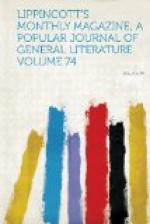The year after the “clothing” of Sister Maria Colomba we witnessed the final ceremony of her “profession”—that is, of her assuming the black veil and renewing her religious vows for life. Hitherto, she had been free to return to the world and marry: henceforth such a return (unless by a dispensation so rarely given that it is practically non-existent) would be sacrilege. The details of the ceremony vary in different orders, and with those which are not cloistered the scene is far less impressive. What we were going to see included the most solemn forms ever used. This time the whole service took place behind the grating: there were no “bridesmaids” now, no shadow of worldly pomp was borrowed to enhance the last and momentous consecration of religion. The novice knelt between the superior and the mistress of novices, each bearing a lighted taper. The white veil was taken from her head, and a black one, previously blessed with holy water sprinkled over it in the form of a cross, substituted: the low chant of the unseen choir of nuns sounded impressively as the echo of another world. Then came the renewal of the dread vows, binding now until death, and the voice of the young girl seemed firm though low: her face wore a calm, peaceful look, subdued by the solemn occasion, yet irrepressibly suggesting a joy unknown in the world, where joy is seldom free from passion. The most interesting ceremony, however, was yet to come. The slow chant shaped itself into the words of the psalm De Profundis, the special prayer which in the Catholic Church is reserved for the dead, and four professed nuns advanced toward their new sister, who was now prostrate at the foot of the altar. Each held the corner of a funeral pall, which they slowly; dropped over the figure of Sister Maria Colomba, and, kneeling, held it over her




